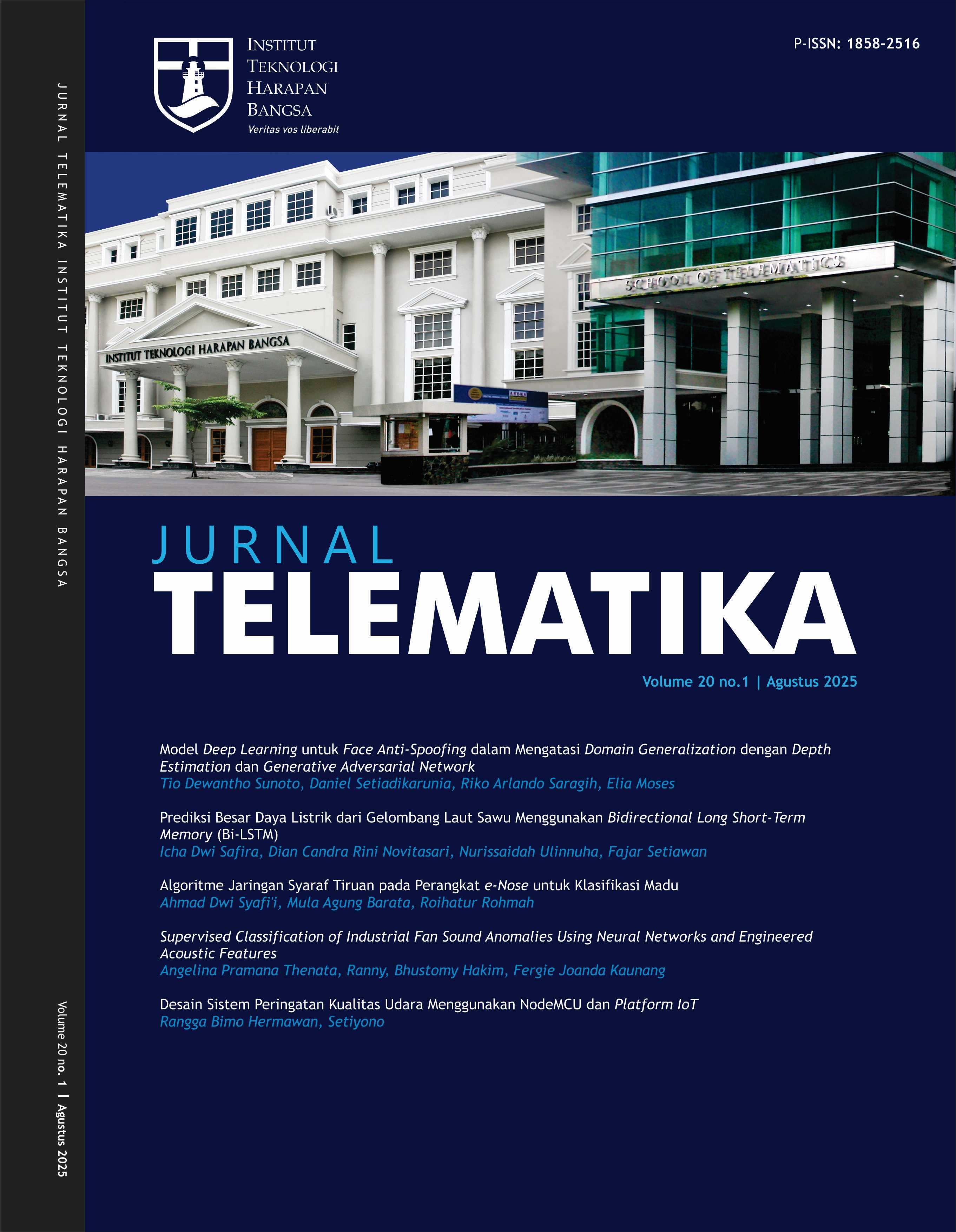Deep Learning Model for Face Anti-Spoofing in Overcoming Domain Generalisation with Depth Estimation and Generative Adversarial Network
DOI:
https://doi.org/10.61769/telematika.v20i1.730Keywords:
face anti-spoofing (FAS), deep learning (DL), generative adversarial neural network (GAN), domain generalization (DG), FAS datasetAbstract
The use of facial biometrics to gain access to a security system is common in communication/computing devices. However, this convenience comes with a vulnerability to security breaches, where facial images can be falsified using photos or videos of someone with access rights. The availability of photos or videos of individuals on social media can exacerbate this. A face anti-spoofing system (FAS) is a crucial component for determining whether an input image is genuine or synthetic in biometric systems that utilize facial image information. Many methods have been used to realise this system, both with a hand-crafted method-based approach and deep learning (DL). However, research on the distribution differences between the test dataset and the training dataset is still rare. This article discusses the use of deep learning (DL)-based models for face anti-spoofing (FAS) applications. This study employs a model that utilizes depth map estimation to identify discriminative features and a generative adversarial network (GAN) to address the issue of distribution differences through a data generation approach. For models implemented with an intra-set simulation scenario, test results for two public datasets, NUAA and CASIA, provided the best results in terms of half total error rate (HTER) metrics, at 2.97% and 2.7% respectively. Meanwhile, simulations comparing the characteristics of the test dataset and the training dataset revealed that applying GAN to enhance the model's generalization ability could reduce the bona fide presentation classification error rate (BPCER) by 9.75%.
References
R. Cai et al., “S-Adapter: generalizing vision transformer for face anti-spoofing with statistical tokens,” IEEE Trans. Inf. Forensics Secur., vol. 19, pp. 8385–8397, 2024, doi: 10.1109/TIFS.2024.3420699.
Y. Liu, Y. Chen, W. Dai, M. Gou, C. T. Huang, and H. Xiong, “Source-free domain adaptation with domain generalized pretraining for face anti-spoofing,” IEEE Trans. Pattern Anal. Mach. Intell., vol. 46, no. 8, pp. 5430–5448, 2024, doi: 10.1109/TPAMI.2024.3370721.
W. Liu and Y. Pan, “Spatio-temporal-based action face anti-spoofing detection via fusing dynamics and texture face keypoints cues,” IEEE Transactions on Consumer Electronics, vol. 70, no. 2, pp. 2401-2413, Feb. 2024, doi: 10.1109/TCE.2024.3361480.
T. Zheng et al., “MFAE: masked frequency autoencoders for domain generalization face anti-spoofing,” IEEE Transactions on Information Forensics and Security, vol. 19, pp. 4058-4069, 2024, doi: 10.1109/TIFS.2024.3371266.
C. Kong, K. Zheng, Y. Liu, S. Wang, A. Rocha, and H. Li, “M3FAS: an accurate and robust multimodal mobile face anti-spoofing system,” IEEE Transactions on Dependable and Secure Computing, vol. 21, no. 6, pp. 1230-1242, Jun. 2024, doi: 10.1109/TDSC.2024.3381598.
W. Zheng, M. Yue, S. Zhao, and S. Liu, “Attention-based spatial-temporal multi-scale network for face anti-spoofing,” IEEE Transactions on Biometrics, Behavior, and Identity Science, vol. 5, no. 2, pp. 296-307, Apr. 2023, doi: 10.1109/TBIOM.2021.3066983.
D. Wang et al., “Wild face anti-spoofing challenge 2023: benchmark and results,” in Proc. IEEE Comput. Soc. Conf. Comput. Vis. Pattern Recognit. Workshops, 2023, pp. 10209048, doi: 0.1109/CVPRW59228.2023.00679.
J. Yang, Z. Lei, and S. Z. Li, “Learn convolutional neural network for face anti-spoofing,” arXiv preprint arXiv:1408.5601, 2014. [Online]. Available: https://arxiv.org/abs/1408.5601
Y. Atoum, Y. Liu, A. Jourabloo, and X. Liu, “Face anti-spoofing using patch and depth-based CNNs,” in Proc. IEEE Int. Joint Conf. Biometrics (IJCB), 2017, pp. 8272713, doi: 10.1109/BTAS.2017.8272713.
Y. Liu, Y. Tai, J. Li, S. Ding, C. Wang, and F. Huang, “Aurora Guard: Real Time Face Anti Spoofing via Light Reflection,” arXiv preprint arXiv:1902.10311, 2019. [Online]. Available: https://arxiv.org/abs/1902.10311
N. M. Adams, "Dataset shift in machine learning," Journal of the Royal Statistical Society Series A: Statistics in Society, vol. 173, no. 1, p. 274, 2010. doi: 10.1111/j.1467-985x.2009.00624_10.x.
J. Wang et al., “Generalizing to unseen domains: a survey on domain generalization,” IEEE Trans. Knowl. Data Eng., vol. 35, no. 8, 2023, pp. 8052–8072, doi: 10.1109/TKDE.2022.3178128.
Y. Liu et al., “Towards unsupervised domain generalization for face anti-spoofing,” Proc. IEEE Int. Conf. Comput. Vis., pp. 20597–20607, 2023, doi: 10.1109/ICCV51070.2023.01888.
Q. Zhou et al., “Instance-aware domain generalization for face anti-spoofing,” Proc. IEEE Comput. Soc. Conf. Comput. Vis. Pattern Recognit., vol. 2023-June, pp. 20453–20463, 2023, doi: 10.1109/CVPR52729.2023.01959.
Downloads
Published
Issue
Section
License
Copyright (c) 2025 Riko Arlando Saragih, Tio Dewantho Sunoto, Daniel Setiadikarunia, Elia Moses

This work is licensed under a Creative Commons Attribution-ShareAlike 4.0 International License.
You are free to:
- Share — copy and redistribute the material in any medium or format for any purpose, even commercially.
- Adapt — remix, transform, and build upon the material for any purpose, even commercially.
- The licensor cannot revoke these freedoms as long as you follow the license terms.
Under the following terms:
- Attribution — You must give appropriate credit, provide a link to the license, and indicate if changes were made. You may do so in any reasonable manner, but not in any way that suggests the licensor endorses you or your use.
- ShareAlike — If you remix, transform, or build upon the material, you must distribute your contributions under the same license as the original.
- No additional restrictions — You may not apply legal terms or technological measures that legally restrict others from doing anything the license permits.
Notices:
You do not have to comply with the license for elements of the material in the public domain or where your use is permitted by an applicable exception or limitation.
No warranties are given. The license may not give you all of the permissions necessary for your intended use. For example, other rights such as publicity, privacy, or moral rights may limit how you use the material.












